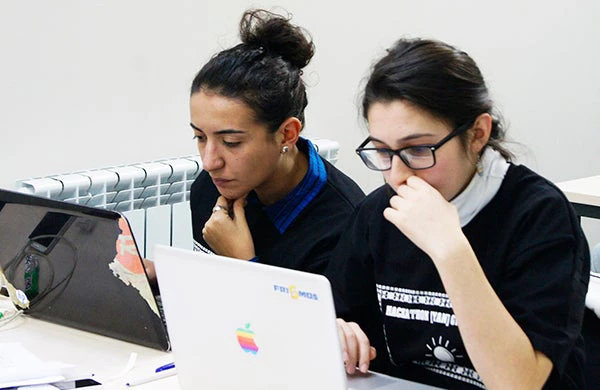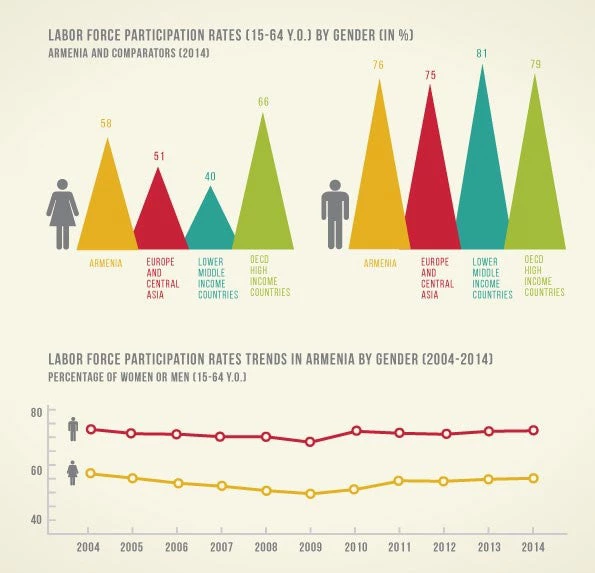As we celebrate International Women’s Day around the world on March 8
th, I’m worried that Armenia is missing out on a key building block for economic growth. Women are 54 percent of the working age population – the ages of 15 to 64 – but only 40 percent of those employed or looking for work. In fact, just a bit more than half (58 percent) of women in that age group participate in the labor market – 18 percentage points lower than for men in Armenia.

Share of women entrepreneurs and top managers is also very low. Within firms with at least 5 employees, women’s ownership continues to be less likely than men’s. According to the 2013 Enterprise Survey, less than a fourth of firms in Armenia (23.6 percent) have some female participation in ownership – well below the regional and world averages. Lower ownership levels and social norms about leadership translate into a minor presence of women in top managerial positions: 17 percent of firms with 5+ employees are managed by women.
Once you have seen the dynamic and creative efforts of economically active Armenian women, the idea that so many are not involved makes you worry that the country is underutilizing its human resources. Many other countries face this reality, missing out on the productive talents of more than half of their working age population, and global research shows that this ‘participation gap’ costs the economy.
The labor market is closely linked to what happens in school.
Unlike in primary and secondary schooling where the enrollment gap is zero, in tertiary education there is a large difference, with 57 percent of females and 38 percent of males of university age enrolled in higher education. However, women tend to specialize more in social sciences, education and health than in technical fields; the opposite is true for men. And this lays the foundation for much of the difference we see in occupations and wages between men and women.
Care responsibilities often fall on women and discourage work.
The difference in work participation by women is greatest for the 25-34 age group. Women with kids (under 5 years) were 17 percent less likely than women with no children to be economically active given similar age, education, and household composition. Women have greater responsibility in household and family care: they spend about 5 times more time than men on those activities. Pre-school institutions, which could help women balance work and childcare responsibilities, are available. Yet they operate at 75 percent capacity, and pre-school attendance is extremely low by international standards, particularly in rural areas (14 percent of children).
Women’s decision to work and the decision to use formal care arrangements are often simultaneous. Since childcare, where available, is typically found to be disproportionately expensive for the average Armenian family, it constitutes an important barrier for economic activity among women. In collaboration with CRRC Armenia, we recently conducted a qualitative study to learn more about this. Women interviewed confirm the strong role these obstacles play. As an unemployed woman from the Lori marz puts it, “It is not worth it to work, because you spend all your money on transportation and kindergarten.”
Unemployed women search longer for jobs.
Unemployment rates are high for both men and women (15.8 and 18.8 percent respectively) but unemployment appears to last longer for women than for men. We believe this is related, among other factors, to skills mismatch and preference for certain types of jobs with certain benefits. Most of the women appear to become unemployed due to job cuts and lay-offs, rather than end of temporary or seasonal work, as in the case of men. Interestingly, the vast majority of respondents to the Caucasus Barometer survey agree with the statement that, "when jobs are scarce, men should have more right to a job."
Employed women tend to earn less than men.
Women earn on average 36 percent less than men, a steady decline from 59 percent in 2002. There could be several reasons for this wage gap. Firstly, self-selection among women into shorter-hours and lower paying jobs, reflected in the occupational segregation patterns observed, might explain much of the gap. Secondly, discrimination by employers might further explain the inequality in average wages. Lastly, different functional roles of men and women within each economic activity are at the heart of the problem.
Norms about working women are changing.
The prevalence of traditional social norms restricts women’s ability to join the labor market: within the household - and in society at large - attitudes towards working women often discourage them from participating in the labor market. CRRC’s qualitative investigation offers many insights into the role and persistence of these norms. Employers themselves acknowledge these difficulties. “There is always public critique towards women who are active and want to go further in their career, and not all women are ready to face this criticism and negative attitudes from the society”, one explains.
However, there are indications that the negative circle of low female labor market attachment and prominence of the care provider role for women, which leads to increased vulnerability and gender-based inequities, is slowly breaking. A working woman from Yerevan nicely describes the positive aspects of women’s work: “I want to stress that work is not about salary only, for me and for many women I know work is part of our lives, it is social networks we have, it is our self-development, and it is a feeling of self-efficiency and self-worth.”
Lower participation in economic activity translates into GDP loss!
As we see, the ‘participation gap’ as well as the related wage gap negatively affect any individual Armenian woman and her family’s income … but there is also a big worry for the economy overall! Research shows that gaps in labor market participation reduce per capita income, while differences in entrepreneurial activities reduce productivity. These effects accumulate into a significant loss in aggregate income for Armenia at large.

P.S. In a few weeks I will share some analysis of what this economic vulnerability could mean, as well as what global experience tells us will work in terms of policies to change the game for the Armenian economy and for Armenian women!
---------------------------------------------
This blog post is also available in Armenian: http://www.worldbank.org/hy/news/opinion/2016/03/07/is-armenia-missing-out-on-a-key-element-of-its-economic-potential

Share of women entrepreneurs and top managers is also very low. Within firms with at least 5 employees, women’s ownership continues to be less likely than men’s. According to the 2013 Enterprise Survey, less than a fourth of firms in Armenia (23.6 percent) have some female participation in ownership – well below the regional and world averages. Lower ownership levels and social norms about leadership translate into a minor presence of women in top managerial positions: 17 percent of firms with 5+ employees are managed by women.
Once you have seen the dynamic and creative efforts of economically active Armenian women, the idea that so many are not involved makes you worry that the country is underutilizing its human resources. Many other countries face this reality, missing out on the productive talents of more than half of their working age population, and global research shows that this ‘participation gap’ costs the economy.
The labor market is closely linked to what happens in school.
Unlike in primary and secondary schooling where the enrollment gap is zero, in tertiary education there is a large difference, with 57 percent of females and 38 percent of males of university age enrolled in higher education. However, women tend to specialize more in social sciences, education and health than in technical fields; the opposite is true for men. And this lays the foundation for much of the difference we see in occupations and wages between men and women.
Care responsibilities often fall on women and discourage work.
The difference in work participation by women is greatest for the 25-34 age group. Women with kids (under 5 years) were 17 percent less likely than women with no children to be economically active given similar age, education, and household composition. Women have greater responsibility in household and family care: they spend about 5 times more time than men on those activities. Pre-school institutions, which could help women balance work and childcare responsibilities, are available. Yet they operate at 75 percent capacity, and pre-school attendance is extremely low by international standards, particularly in rural areas (14 percent of children).
Women’s decision to work and the decision to use formal care arrangements are often simultaneous. Since childcare, where available, is typically found to be disproportionately expensive for the average Armenian family, it constitutes an important barrier for economic activity among women. In collaboration with CRRC Armenia, we recently conducted a qualitative study to learn more about this. Women interviewed confirm the strong role these obstacles play. As an unemployed woman from the Lori marz puts it, “It is not worth it to work, because you spend all your money on transportation and kindergarten.”
Unemployed women search longer for jobs.
Unemployment rates are high for both men and women (15.8 and 18.8 percent respectively) but unemployment appears to last longer for women than for men. We believe this is related, among other factors, to skills mismatch and preference for certain types of jobs with certain benefits. Most of the women appear to become unemployed due to job cuts and lay-offs, rather than end of temporary or seasonal work, as in the case of men. Interestingly, the vast majority of respondents to the Caucasus Barometer survey agree with the statement that, "when jobs are scarce, men should have more right to a job."
Employed women tend to earn less than men.
Women earn on average 36 percent less than men, a steady decline from 59 percent in 2002. There could be several reasons for this wage gap. Firstly, self-selection among women into shorter-hours and lower paying jobs, reflected in the occupational segregation patterns observed, might explain much of the gap. Secondly, discrimination by employers might further explain the inequality in average wages. Lastly, different functional roles of men and women within each economic activity are at the heart of the problem.
Norms about working women are changing.
The prevalence of traditional social norms restricts women’s ability to join the labor market: within the household - and in society at large - attitudes towards working women often discourage them from participating in the labor market. CRRC’s qualitative investigation offers many insights into the role and persistence of these norms. Employers themselves acknowledge these difficulties. “There is always public critique towards women who are active and want to go further in their career, and not all women are ready to face this criticism and negative attitudes from the society”, one explains.
However, there are indications that the negative circle of low female labor market attachment and prominence of the care provider role for women, which leads to increased vulnerability and gender-based inequities, is slowly breaking. A working woman from Yerevan nicely describes the positive aspects of women’s work: “I want to stress that work is not about salary only, for me and for many women I know work is part of our lives, it is social networks we have, it is our self-development, and it is a feeling of self-efficiency and self-worth.”
Lower participation in economic activity translates into GDP loss!
As we see, the ‘participation gap’ as well as the related wage gap negatively affect any individual Armenian woman and her family’s income … but there is also a big worry for the economy overall! Research shows that gaps in labor market participation reduce per capita income, while differences in entrepreneurial activities reduce productivity. These effects accumulate into a significant loss in aggregate income for Armenia at large.

P.S. In a few weeks I will share some analysis of what this economic vulnerability could mean, as well as what global experience tells us will work in terms of policies to change the game for the Armenian economy and for Armenian women!
---------------------------------------------
This blog post is also available in Armenian: http://www.worldbank.org/hy/news/opinion/2016/03/07/is-armenia-missing-out-on-a-key-element-of-its-economic-potential


Join the Conversation